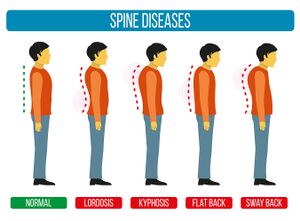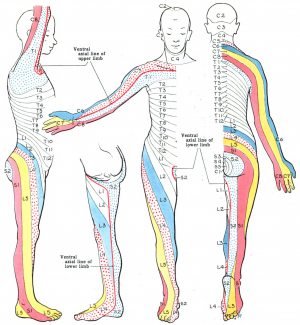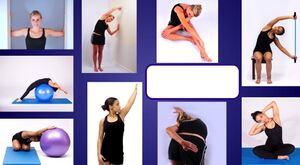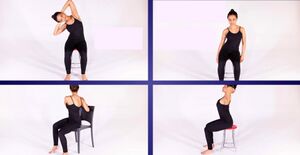Assessment and Treatment of the Thoracic Spine
Top Contributors - Jess Bell, Kim Jackson, Kirenga Bamurange Liliane, Tarina van der Stockt, Merinda Rodseth, Lucinda hampton, Olajumoke Ogunleye and Aminat Abolade
Subjective Assessment[edit | edit source]
Detailed information on the assessment of the thoracic spine is available here, but specific questions to consider in the subjective assessment include:[1]
- How did the problem begin? How long has it been a problem?
- How has the pain progressed over time?
- Is there a history of overload or trauma?
- Does the patient have pain with breathing? And during which part of the breath does this occur?
- What effect does coughing and / or sneezing have?
- Can the patient lie on the affected side at night?
- How is the pain behaving and what is the level of irritability?
- Consider in particular more stiffness
- If there is stiffness for a prolonged period in the morning, and a history of enthesopathies, the patient may have a spondyloarthropathy[1][2]
- What are the specific functional impairments? (e.g. during sport, activities of daily living)
- What is the patient’s medical history?
- Essential to know due to spinal masqueraders in the thoracic spine
- Are there any psychosocial factors contributing to the pain?
- The sympathetic nervous system is prominent in the thoracic region[1]
- Are there any red flags?[3]
Pain can be caused by inflammation, or it may originate in the cartilage, ligaments, bone (fracture) or the nerve root:[1]
- Nerve root or facet pain may be described as lancinating / nauseating and it may radiate and follow angulation of rib
- Costochondritis tends to be described as a deep, boring, aching pain in the chest wall that may radiate (often posteriorly or to the neck)
- Rib fracture or intercostal strain is typically described as a sudden, sharp / piercing pain, which is then aggravated by laughing, sneezing, coughing, deep breaths or any type of straining manoeuvre
- When patients have immobility, they tend to report stiffness, restricted movement, or a sense of feeling ‘stuck’
Objective Assessment[edit | edit source]
The objective examination is guided by findings in the subjective interview. Remember:[1]
- It is essential to understand which structures are loaded during each test
- Keep tests to a minimum
- “Less is more” to avoid flaring up the patient
- Consider combinations of tests
- The best ‘special test’ is the one the patient demonstrates to you
- Consider the diaphragm
During the assessment, the therapist should develop a sound hypothesis. “If you can’t find it, you can’t assess it and you can’t treat it”.[1]
Objective Testing[edit | edit source]
The following tests should be included in an objective examination of the thoracic spine:[1]
- Static and dynamic postural assessment:
- Watch how the patient moves / drifts / hinges
- Consider different types of postural dysfunctions[4](see Figure 1)
- Is the postural change a primary problem or related to something else in the chain (e.g. lumbopelvic dysfunction)
- Breathing mechanics
- ROM tests from neutral
- Look for intersegmental restrictions
- Assess from behind
- Inter-ring and articular palpation during motion
- Motor control and strength tests
- Sitting
- Puppy lie
- 4 point
- Neurodynamic tests
- Neurological
- Thoracic dermatome testing (see Figure 2)
- Palpation, including the clavicle and first rib
Active Thoracic Movement Tests[edit | edit source]
During the active movement tests:[1]
- Assess the patient in sitting in order to isolate the thoracic spine (by blocking the lumbar spine)
- Assess for asymmetry of movement and any segmental cause of restriction
- Remember that motor control is also important in the thoracic region, not just stiffness
Thoracic Flexion and Extension[edit | edit source]
- Flexion: feel for anterior tilt of the ribs
- Extension: feel for posterior rib tilt
- NB extension is the most limited movement in the thoracic spine[9]
Thoracic Rotation[edit | edit source]
Rotation is one of the most useful tests for the thoracic spine. During rotation movements, it is possible to identify:[1]
- Stiffness
- Sequencing issues
Thoracic Side Bend / Lateral Shift[edit | edit source]
Assess the patient from behind - it is only necessary to look from the front if you wish to specifically assess the ribs from this position. During thoracic side bend there is:[1]
- Contralateral rib translation
- Ribs approximate on the ipsilateral side
- Ribs separate on the contralateral side
Treatment[edit | edit source]
Sleep[edit | edit source]
Sleep is the most powerful antioxidant.[1] It is recognised that there is a bi-directional relationship between pain and sleep.[10]
Thoracic Manipulation[edit | edit source]
It is still not known if / why thoracic manipulation works, but it has been found that thoracic manipulation can decrease pain, improve mobility and enhance a patient’s feeling of health.[11]
- There is no evidence that one manipulation is better than another
- There is no evidence that thoracic manipulation has a long-term effect, so if it is used, it should be in combination with specific rehabilitation
- Joint position, direction, velocity and force are all variables that should be considered[1]
Postural Correction and Motor Control[edit | edit source]
Correcting a patient’s posture can also have a positive impact on a patient’s pain.[1]
- Consider the centre of gravity
- Look for areas of muscle spasm or hyperactivity
Iliocostalis Release[edit | edit source]
Iliocostalis is the most lateral of the erector spinae.[12] Patients with significant thoracic kyphosis and lumbar lordosis may have increased activity of iliocostalis. This muscle can be released under the 10th and 11th ribs.[1]
Posterior-Anterior Glides[edit | edit source]
Patients with inverted thoracic spines, rotated spine and increased kyphosis will likely find posterior-anterior (PA) glides of the spinous processes irritable as they are highly nociceptive.[1]
Instead, it can be beneficial to perform a PA glide on the rib angle, thus mobilising 13 articulations per thoracic ring. For individuals with inverted spines, this will create an anterior-posterior (AP) movement on the spinous process.[1]
For patients with increased kyphosis, a PA glide on the rib angle while performing an AP glide on the anterior shoulder / coracoid can be effective. A rotatory technique for patients with kyphosis can be effective.[1]
Exercise Therapy[edit | edit source]
A survey of thoracic spine management trends in the UK found that exercise is used widely as a treatment modality despite limited supporting evidence.[13]
In terms of exercise prescription, speed, starting positions, dosage and load progression have not been investigated. However, exercises which aim to stretch, mobilise and stabilise can be beneficial in clinical practice.[1]
Specific Exercises[edit | edit source]
Stretches for the thoracic spine are shown in Figure 3. Figure 4 shows stretches that can specifically address an inverted thoracic spine.
Figures 5 and 6 show exercises to mobilise the thoracic spine.
Thoracic stretch of inverted position (lordosis) - rhomboid / lev scap
Mobilise -IMAGE
Ride side flexion, right lateral translation, seated right rotation, extension - IMAGES
Thoracic Rotation - HWANG 2017, JOHNSTON 2012
Stabilise
Thoracic stability / motor control - IMAGE gROOVI - closed chain and then strengthen through range
Moderately advanced kinetic chain exercises, include:
- Backward lunge with right shoulder external rotation (IMAGE
- Thoracic rotation
- Glutes
- Force closure of posterior and anterior sling
- Mid and lower traps
- Right shoulder posterior cuff
References[edit | edit source]
- ↑ 1.00 1.01 1.02 1.03 1.04 1.05 1.06 1.07 1.08 1.09 1.10 1.11 1.12 1.13 1.14 1.15 1.16 1.17 1.18 Bell-Jenje T. Assessment and Treatment of the Thoracic Spine Course. Physioplus, 2021.
- ↑ Martey C. Co-morbidities within Spondyloarthritis Course. Physioplus, 2020.
- ↑ Finucane LM, Downie A, Mercer C, Greenhalgh SM, Boissonnault WG, Pool-Goudzwaard AL et al. International framework for red flags for potential serious spinal pathologies. J Orthop Sports Phys Ther. 2020;50(7):350-72.
- ↑ Czaprowski D, Stoliński Ł, Tyrakowski M, Kozinoga M, Kotwicki T. Non-structural misalignments of body posture in the sagittal plane. Scoliosis Spinal Disord. 2018;13:6.
- ↑ Jones MR, Prabhakar A, Viswanath O, Urits I, Green JB, Kendrick JB et al. Thoracic outlet syndrome: a comprehensive review of pathophysiology, diagnosis, and treatment. Pain Ther. 2019;8(1):5-18.
- ↑ Li N, Dierks G, Vervaeke HE, Jumonville A, Kaye AD, Myrcik D et al. Thoracic outlet syndrome: a narrative review. J Clin Med. 2021;10(5):962.
- ↑ John Gibbons. Upper Limb Tension Test (ULTT) for the Median Nerve (C5-T1 Brachial plexus). Available from: https://www.youtube.com/watch?v=fhsrNKWVh0s [last accessed 4/9/2021]
- ↑ ohn Gibbons. Upper Limb Tension Test - Radial Nerve (C5-T1 Brachial Plexus). Available from: https://www.youtube.com/watch?v=VngRTMhAlGE [last accessed 4/9/2021]
- ↑ Wilke HJ, Herkommer A, Werner K, Liebsch C. In vitro analysis of the segmental flexibility of the thoracic spine. PLoS One. 2017;12(5):e0177823.
- ↑ Haack M, Simpson N, Sethna N, Kaur S, Mullington J. Sleep deficiency and chronic pain: potential underlying mechanisms and clinical implications. Neuropsychopharmacology. 2020;45(1):205-16.
- ↑ Takatalo J, Leinonen T, Rytkönen M, Häkkinen A, Ylinen J. The effect of thoracic spine manipulation on thoracic spine pain and mobility – Preliminary results of RCT. Manual Therapy. 2016;25:e161.
- ↑ Henson B, Kadiyala B, Edens MA. Anatomy, Back, Muscles. [Updated 2021 Aug 10]. In: StatPearls [Internet]. Treasure Island (FL): StatPearls Publishing; 2021 Jan-. Available from: https://www.ncbi.nlm.nih.gov/books/NBK537074/
- ↑ Heneghan NR, Gormley S, Hallam C, Rushton A. Management of thoracic spine pain and dysfunction: A survey of clinical practice in the UK. Musculoskelet Sci Pract. 2019;39:58-66.











